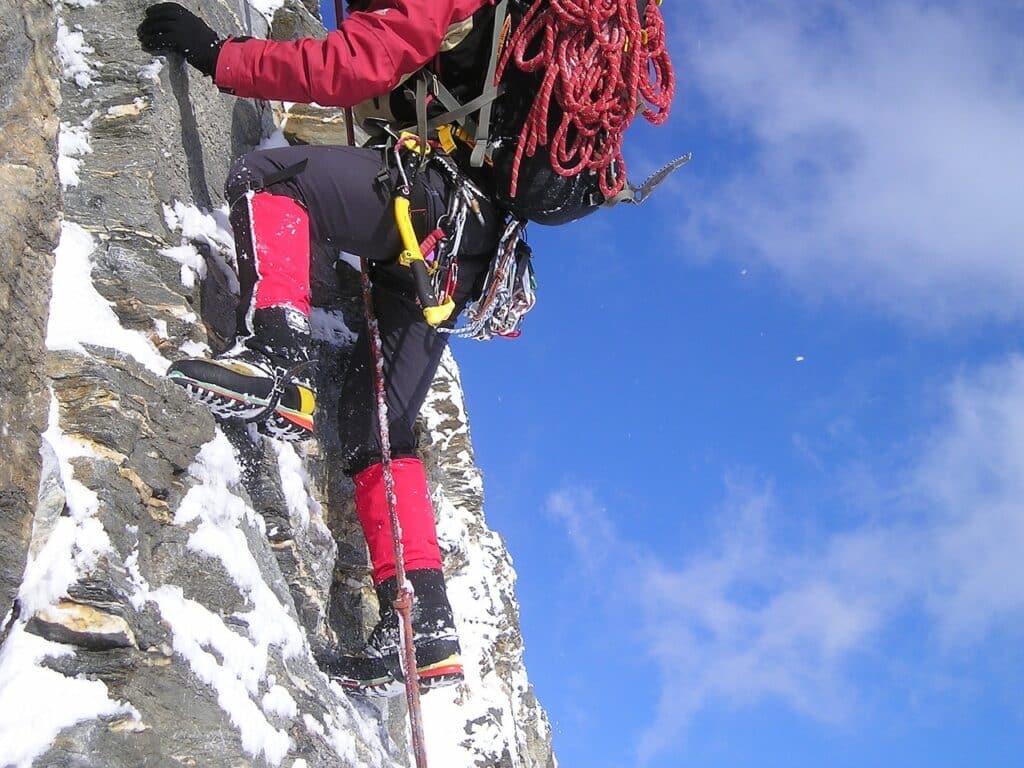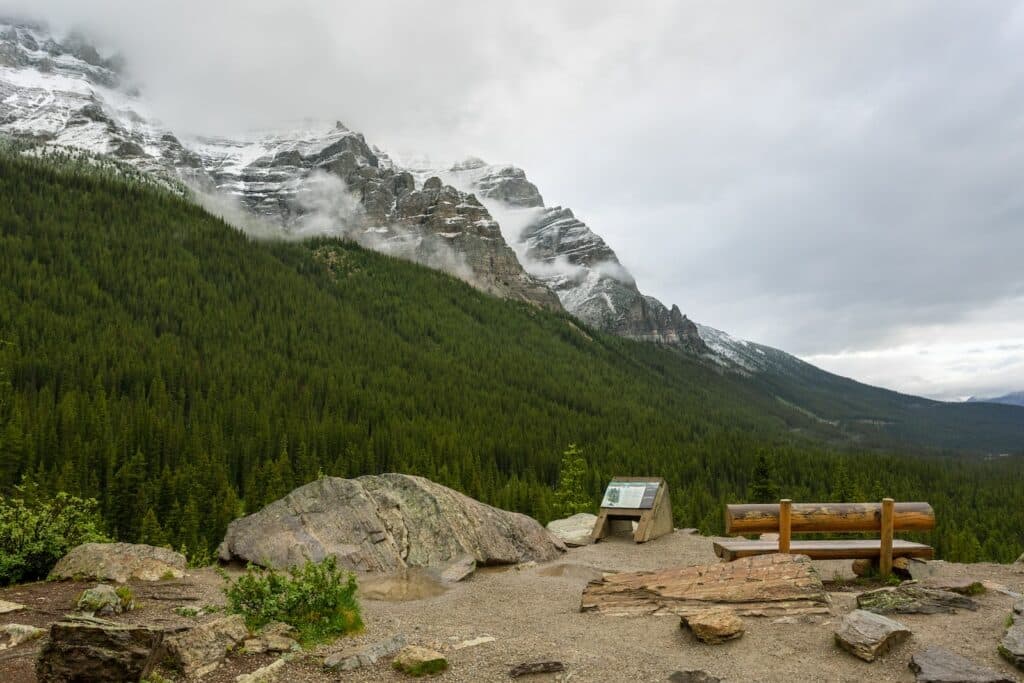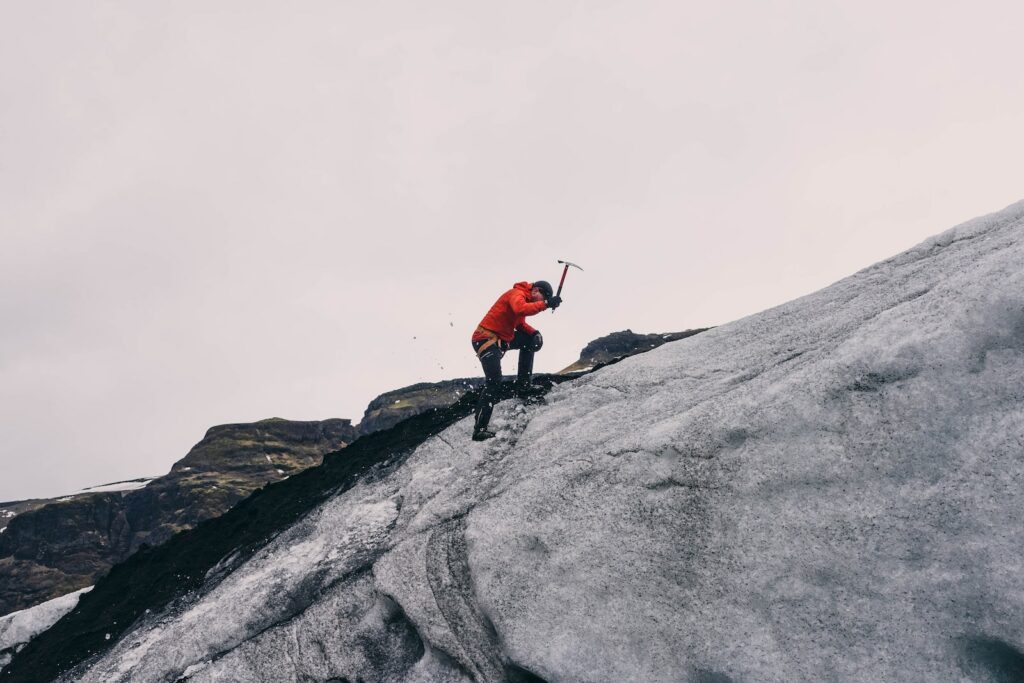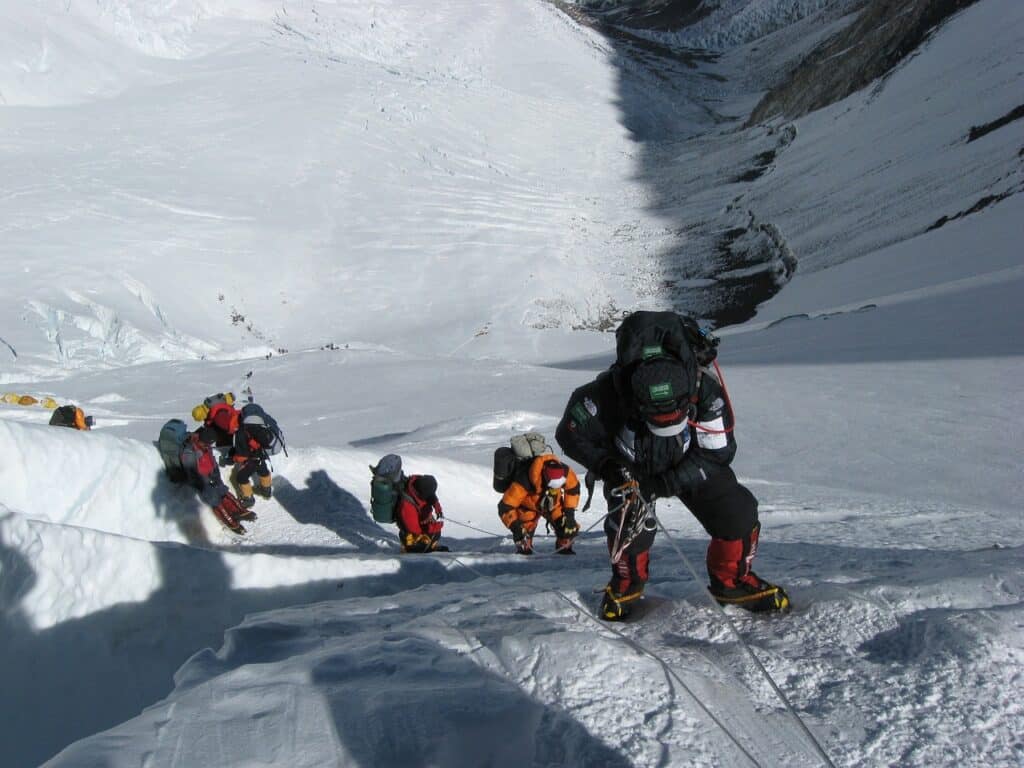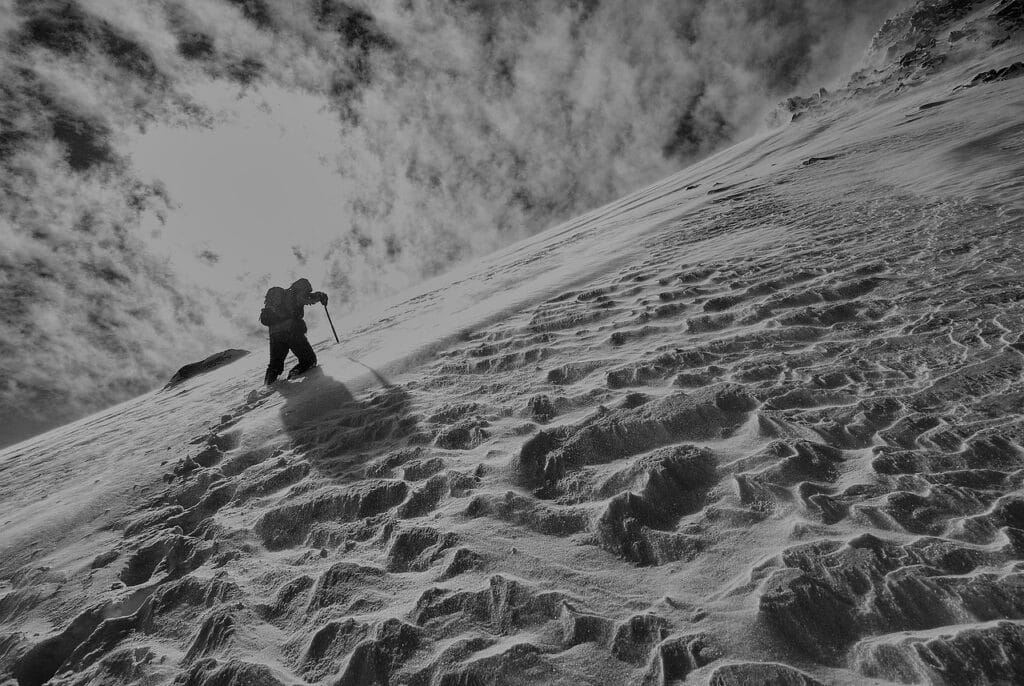Table of Contents
ToggleIce Climbing: An Introduction
Ice climbing is an exhilarating activity that combines elements of rock climbing, mountaineering, and winter sports. It involves ascending frozen waterfalls, ice-covered cliffs, and alpine walls using specialized gear and techniques. If you’re new to ice climbing, let’s explore what it entails and the gear you’ll need to get started.
What is Ice Climbing?
Ice climbing is the act of scaling frozen formations such as waterfalls and ice-covered rocks using specialized equipment and techniques. It requires a unique set of skills, strength, and endurance. Ice climbers use tools like ice axes and crampons to grip the ice and ascend vertical or near-vertical ice walls. The sport can be physically demanding, requiring balance, agility, and a strong mental focus. Ice climbing offers a thrilling and challenging experience for those seeking adventure in icy landscapes.
Gear and Equipment for Ice Climbing
Ice climbing requires specialized gear to ensure safety and comfort while navigating icy terrain. Here are some essential equipment items for ice climbing:
Ice Axes
Ice axes are one of the most crucial tools for ice climbers. They consist of a curved shaft, a pick, and an adze or hammer. Ice axes provide stability and help climbers maneuver through ice by providing a secure grip. They also aid in self-arresting during a fall. There are various types and sizes of ice axes available, each designed for specific ice climbing conditions. Find more information about ice climbing axes here.
Crampons
Crampons are metal spikes that attach to your boots and provide traction on icy surfaces. They have sharp points that grip the ice, allowing climbers to ascend vertical or near-vertical ice walls. Crampons come in different designs and configurations, depending on the type of ice climbing you plan to do. Learn more about crampons for ice climbing here.
Protective Clothing
Protective clothing is essential for ice climbing, as it helps insulate your body and protects you from the cold and potential hazards. Layering is key to regulating body temperature. A base layer should wick away moisture, while an insulating mid-layer provides warmth. A waterproof and breathable outer layer protects against wind, snow, and ice. Don’t forget to wear appropriate gloves, helmets, and other protective accessories. Find more information about ice climbing gloves and helmets here and here.
Ropes and Harnesses
Ropes and harnesses are crucial for safety in ice climbing. Climbers use ropes to protect themselves from falls and to establish anchors for belaying. Harnesses are worn around the waist and thighs, providing a secure attachment point for the rope. It’s essential to choose a harness that fits well and is comfortable for extended periods of climbing. Learn more about ice climbing harnesses here.
These are just a few examples of the gear and equipment needed for ice climbing. Each piece of equipment plays a vital role in ensuring your safety and success on the ice. If you’re interested in exploring more gear options and equipment for ice climbing, check out our article on ice climbing gear and ice climbing equipment.
Ice climbing offers a unique and challenging experience for climbers of all skill levels. Before embarking on an ice climbing adventure, it’s important to acquire the necessary skills, knowledge, and equipment. With the right gear and proper training, you can safely enjoy the thrill of conquering icy landscapes and pushing your limits as an ice climber.
Popular Ice Climbing Destinations
When it comes to ice climbing, there are several breathtaking destinations around the world that attract climbers of all skill levels. Whether you are a beginner or an experienced climber, these locations offer unique challenges and stunning landscapes. Here are three notable ice climbing destinations that should be on every ice climber’s bucket list:
Yosemite National Park
Yosemite National Park, located in California, is renowned for its stunning granite walls and breathtaking scenery. While it is famous for its rock climbing, it also offers incredible opportunities for ice climbing. The park’s frozen waterfalls and glistening ice formations provide a dramatic backdrop for climbers seeking a thrilling ice climbing experience.
Within Yosemite, one of the most popular ice climbing areas is the Lee Vining Canyon, where climbers can find a variety of ice routes suitable for different skill levels. From beginner-friendly routes to more challenging vertical ice walls, Yosemite offers a diverse range of options for ice climbers to explore. The park’s unique combination of natural beauty and diverse ice formations make it a must-visit destination for ice climbing enthusiasts.
Ouray Ice Park
Located in Colorado, Ouray Ice Park is one of the most accessible and popular ice climbing destinations in North America. The park features a man-made ice climbing venue where water is piped from the nearby Uncompahgre River to create stunning ice formations on the canyon walls. This controlled environment provides a safe and reliable ice climbing experience for climbers of all levels.
Ouray Ice Park offers a range of ice climbing routes, from easy beginner-friendly lines to challenging overhanging ice walls. The park’s unique layout and extensive infrastructure, including fixed anchors and top-rope setups, make it an ideal destination for ice climbers looking to refine their skills or try out new techniques. The park’s proximity to the town of Ouray also makes it a convenient and vibrant base for climbers to enjoy après-climbing activities.
Canadian Rockies
The Canadian Rockies are renowned for their majestic peaks and pristine wilderness, making them a paradise for ice climbers. This vast mountain range offers some of the most iconic and sought-after ice climbing destinations in the world. From frozen waterfalls to towering ice pillars, the Canadian Rockies provide a wide range of ice formations for climbers to conquer.
In the Canadian Rockies, climbers can explore destinations such as the Athabasca Glacier, the Weeping Wall, and many more. These locations offer a mix of challenging ice routes suitable for experienced climbers, as well as more moderate routes for beginners looking to test their skills. The awe-inspiring beauty of the Canadian Rockies combined with the exhilaration of ice climbing creates an unforgettable experience for climbers of all levels.
By exploring these popular ice climbing destinations, you can immerse yourself in the beauty of frozen landscapes and challenge yourself on vertical ice walls. Remember to always prioritize safety and be prepared with the necessary gear and equipment. To learn more about the essential gear for ice climbing, check out our article on ice climbing gear. Whether you’re drawn to the granite walls of Yosemite, the accessibility of Ouray Ice Park, or the stunning beauty of the Canadian Rockies, these destinations offer incredible opportunities for ice climbers to push their limits and create lifelong memories.
Physical Demands and Safety in Ice Climbing
Ice climbing is a physically demanding activity that requires a unique combination of strength, endurance, and balance. It is considered one of the most challenging forms of mountaineering, requiring both physical fitness and technical skill. Let’s explore the physical fitness requirements and safety considerations associated with ice climbing.
Physical Fitness for Ice Climbing
To engage in ice climbing, it is important to have a good level of overall fitness. Some key aspects of physical fitness that are beneficial for ice climbing include:
- Strength: Upper body and core strength are essential for maintaining stability and control while climbing. Strengthening exercises such as pull-ups, push-ups, and core exercises help develop the necessary strength.
- Endurance: Ice climbing can be physically demanding, requiring sustained effort over long periods. Developing cardiovascular endurance through activities like running, cycling, or hiking helps improve stamina and reduces fatigue during climbs.
- Balance: Good balance is crucial for ice climbing, as climbers need to maintain stability on varying surfaces. Activities like yoga or balance training exercises can help improve overall balance and body control.
It is advisable to engage in a specific training program to prepare for ice climbing. This may involve a combination of strength training, cardiovascular exercises, and balance exercises. Consulting with a professional trainer or experienced ice climber can help develop a training plan tailored to individual needs.
Safety Considerations in Ice Climbing
Safety is of paramount importance in ice climbing, and climbers must be aware of the potential risks and take appropriate precautions. Here are some important safety considerations:
- Helmets: Wearing a helmet is crucial for protecting the head from falling ice and potential impacts. A helmet can significantly reduce the risk of head injuries, which are common in ice climbing accidents.
- Eye Protection: Using a face shield or goggles is essential to protect the eyes from ice chips, falling debris, and harsh weather conditions. The eyes are particularly vulnerable during ice climbing, and proper eye protection is vital for safety.
- Knowledge and Experience: Learning from experienced climbers and seeking professional instruction can provide valuable insights into safe climbing techniques, hazard identification, and risk management.
- Assessing Ice Conditions: Evaluating the quality of the ice is crucial for safety. Climbers should pay attention to factors such as ice thickness, stability, and potential hazards such as loose ice or overhanging sections. It is important to be cautious and make informed decisions based on the current conditions.
- Safety Equipment: Using appropriate safety equipment, such as harnesses, ropes, and anchors, is essential for protecting against falls and providing a safety backup during climbs. Familiarize yourself with the proper use of equipment and ensure it is in good condition before each climb.
By prioritizing physical fitness and adhering to safety measures, climbers can enjoy the thrill of ice climbing while minimizing the risk of accidents. Always remember to practice responsible climbing techniques and stay informed about current safety guidelines.
Techniques and Skills for Ice Climbing
Ice climbing requires proper technique to maintain stability, minimize energy expenditure, and prevent injury. Key elements of technique include efficient movement, precise foot placements, and effective use of tools and crampons. Let’s explore two essential aspects of ice climbing technique: ice climbing movement and using ice axes and crampons.
Ice Climbing Technique and Movement
Efficient movement is crucial for successful ice climbing. Here are some key considerations when it comes to technique and movement:
- Balance and Weight Distribution: Maintaining balance and distributing weight properly is essential. Shift your weight over your feet to ensure stability and prevent slipping. Keep your body close to the ice wall to maximize contact and improve control.
- Precise Foot Placements: Look for secure footholds and make deliberate placements with the front points of your crampons. Aim for areas with good ice quality and avoid fragile or brittle sections.
- Legs vs. Arms: Utilize your leg muscles as the primary source of power and endurance. Avoid relying solely on your arms, as this can lead to fatigue more quickly.
- Resting and Shaking Out: Take advantage of ledges or features to rest and shake out your arms. This helps to alleviate fatigue and maintain strength for the climb.
Developing proper ice climbing technique takes practice and experience. Consider taking lessons or hiring a guide to learn and refine your movement skills. Watching instructional videos and reading climbing guides can also provide valuable insights into technique. For more resources and information on ice climbing, check out our article on ice climbing videos.
Using Ice Axes and Crampons
Ice axes and crampons are essential tools for ice climbers. Understanding how to use them effectively is crucial for safe and efficient climbing:
- Ice Axes: Ice axes are specialized tools designed for ice climbing. They have a curved pick for stability and a sharp point for penetration. When using ice axes:
- Swing: Swing the ice axe overhead and drive the pick into the ice. Maintain a secure grip and aim for solid placements.
- Matching: Matching refers to placing both ice axes at the same level. This technique provides stability and balance on horizontal or less steep sections.
- Hooking: Hooking involves using the curved pick of the ice axe to gain leverage on features such as ice blobs or rock edges. This technique can assist with upward progress.
- Crampons: Crampons are metal spikes attached to your boots, providing traction on icy surfaces and preventing slipping. When using crampons:
- Front Pointing: Front pointing involves using the front points of the crampons to penetrate the ice. Aim for secure placements by ensuring the front points are fully engaged.
- Flat Footing: Flat footing refers to using the horizontal front part of the crampons on less steep sections. This technique provides stability and allows for weight distribution across a larger surface area.
Proper use of ice axes and crampons is essential for safety and efficiency while ice climbing. It is recommended to receive instruction from experienced climbers or take courses to learn and practice these techniques. For more information on ice climbing gear and equipment, including ice axes and crampons, visit our article on ice climbing gear.
Mastering ice climbing technique and using ice axes and crampons require dedication and practice. As you gain experience and improve your skills, you’ll be able to tackle more challenging routes and enjoy the thrill of ice climbing to the fullest. Stay safe, continually learn, and embrace the adventure of ice climbing!
Training for Ice Climbing
Preparing for ice climbing involves more than just acquiring the necessary gear and equipment. To excel in this challenging sport, it’s crucial to engage in targeted training exercises that enhance both strength and cardiovascular fitness. In this section, we will explore two key aspects of training for ice climbing: strength and conditioning exercises, and cardiovascular fitness.
Strength and Conditioning Exercises
Ice climbing heavily relies on the strength and endurance of the forearms. Building a base of strength endurance in the forearms is important to fight off fatigue and prevent failure during a climb. One effective exercise for this is ice tool hangs, where you hang from ice tools to build forearm strength endurance. Incorporating regular ice tool hangs into your training routine can significantly improve your grip strength and endurance.
Upper-body strength is also crucial in ice climbing. Ice tool pull-ups, performed using ice tools instead of a traditional bar, are an excellent exercise to build upper-body strength and boost confidence in tackling steep sections of a climb. Variations of ice tool pull-ups, such as using a harness and adding weight or attempting one-arm pull-ups, provide further challenges for the muscles.
Calf raises are another important exercise for ice climbers, as climbing ice can put a lot of strain on the calves. Strong calves are crucial for maintaining stability and endurance during climbs and reducing the risk of calf exhaustion. Incorporating various variations of calf raises into your training routine can target different muscle groups and challenge the calves.
Lower body strength is essential in ice climbing, and squats are an effective exercise for building lower body strength and balance. The motion of standing up while climbing ice is similar to the motion of a squat. Incorporating different variations of squats, such as weighted squats or single-leg squats, into your training routine can improve stability, confidence in foot placement, and reduce strain on the forearms.
Cardiovascular Fitness for Ice Climbing
Ice climbing also requires a baseline level of cardiovascular fitness. Long approaches and steep climbs are common in ice climbing, and maintaining a solid cardio routine can improve energy management, prevent fatigue, and enable better endurance while climbing. Engaging in winter activities such as cross-country skiing, winter trail running, and snowshoeing are excellent exercises for winter cardio. These activities not only enhance cardiovascular fitness but also provide an opportunity to practice balance and stability in snowy and icy conditions.
Incorporating both strength and conditioning exercises, as well as cardiovascular fitness training, into your ice climbing preparation will help you build the necessary physical attributes to tackle the challenges of ice climbing. Remember to always prioritize safety and gradually increase the intensity and duration of your training as you progress. Be sure to consult a professional or experienced ice climber for guidance and support throughout your training journey.
For more information on ice climbing, gear, techniques, and safety, check out our comprehensive guides and resources on ice climbing.


